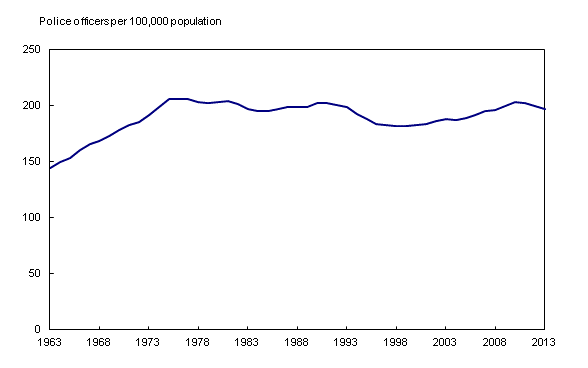Police personnel and expenditures, 2013
Archived Content
Information identified as archived is provided for reference, research or recordkeeping purposes. It is not subject to the Government of Canada Web Standards and has not been altered or updated since it was archived. Please "contact us" to request a format other than those available.
Released: 2014-03-27
As of May 15, 2013, there were 69,272 police officers in Canada, 233 fewer than in 2012. The rate of police strength, as measured by the number of police officers per capita, declined 1.5% to 197 police officers per 100,000 population. This was the third consecutive annual decrease.
Despite recent declines, Canada's rate of police officer strength was 5% higher than a decade ago.
The rate of police strength decreased in every province and territory in 2013, with the exception of Yukon and Nunavut. Manitoba had the highest rate of police strength among provinces for the second consecutive year at 213 police officers per 100,000 population. Prince Edward Island reported the lowest rate at 160 officers per 100,000 population.
The rate of police strength was down in 16 of Canada's 33 census metropolitan areas (CMAs) in 2013. Declines ranged from 0.6% in Kitchener–Cambridge–Waterloo and Sherbrooke to 2.9% in Trois-Rivières. The rate of police strength remained stable in 10 CMAs, while 7 posted increases ranging from 0.7% in Brantford to 11.0% in Kelowna.
Thunder Bay and Winnipeg reported the highest rates of police strength at 189 officers per 100,000 population. The lowest was in Moncton (111 officers per 100,000 population).
Police services employed almost 27,900 civilians on the 2013 snapshot day of May 15. The ratio of officers to civilians has been slowly declining over the long term. A decade ago, there were 2.8 officers employed for every civilian compared with 2.5 in 2013.
For the second year in a row, the number of female officers increased while the number of male officers declined. Females accounted for 20% of all police officers in 2013 compared with 16% a decade ago.
In the 2012 calendar year or the 2012/2013 fiscal year, 11% of police officers were eligible for retirement, but only 2% of police officers actually retired. Retirements were the most common reason officers left a police service that year (69%).
Expenditures on policing totalled $13.5 billion in 2012, up 2.8% over 2011 when controlling for inflation. With the exception of 2011, constant dollar spending on policing has been increasing since the late 1990s.
After controlling for inflation, Nova Scotia was the lone jurisdiction to report no change in spending on policing in 2012. Spending rose in all other jurisdictions, with increases ranging from 1% in Ontario and Quebec to 13% in Nunavut.
Note to readers
In Canada, information on police personnel and expenditures is collected by Statistics Canada through the annual Police Administration Survey. Using data reported by each police service in Canada, this report provides details on police personnel at the national, provincial/territorial, and census metropolitan area levels.
Data in this report represent two distinct time periods. Most of the information on police personnel is based on a "snapshot date" of May 15, 2013, while data on hirings, departures, retirements, eligibility to retire, and expenditures represent the calendar year ending December 31, 2012 (or March 31, 2013, for those police services operating on a fiscal year).
In this release, rates with a percent change that rounds to 0% are considered stable.
The Juristat article "Police Resources in Canada, 2013" (Catalogue number85-002-X) is now available. From the Browse by key resource module of our website under Publications, choose All subjects, then Crime and justice, and Juristat.
Contact information
For more information, or to enquire about the concepts, methods or data quality of this release, contact us (toll-free 1-800-263-1136; 514-283-8300; infostats@statcan.gc.ca) or Media Relations (613-951-4636; statcan.mediahotline-ligneinfomedias.statcan@canada.ca).
- Date modified:


